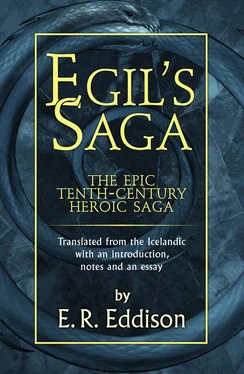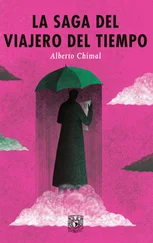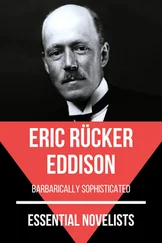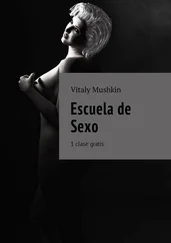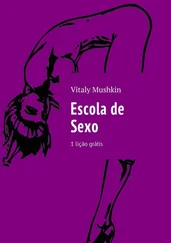The priest’s neighbours and dependants were called his ‘thingmen’, because they followed him to the Thing or parliament, where laws were made and suits tried. The Thorsness Thing was the first of these assemblies. Later, in 930, the Althing was established in the south-west beyond Mossfellsheath, as the annual meeting-place for all Iceland. It is said that a man named Grim Goatshoe travelled all over Iceland to find the best place for the Althing, “and every man in the land here brought him a penny for it; but he gave that fee afterward to the tempie”. The place was chosen, no doubt, for its accessibility, but it was fitted too by its grandeur to be the seat of the hallowed Thing: the quiet lake, the three-mile black lava rampart of the Almannagjà, or Great Rift, over which the little river Axewater falls and thunders, the level water-meadows and green slopes where the chiefs had their booths, set about with lava-fields torn with profound rifts and chasms, the circling mountains. It is a remarkable evidence of the political and legal instinct which co-existed in the Icelandic mind along with its intense individualism, that for hundreds of years every man of any account in Iceland rode to this place yearly; a journey, from some parts of the country, not of days but of weeks.
This, then, was the Icelandic commonwealth: scattered communities, each owing a loose allegiance to its chief or temple-priest, held together by the bond of race and the yearly meetings of the Althing. The Icelanders had come from Norway because they were minded to be their own masters, and in no other civilized community has there been greater freedom of the individual. There was no executive government: the enforcement of the law rested, in the last resort, on private vengeance. Nor (in theory, at any rate) was the bond of priest and thingman more than a matter of honourable contract between free men, which could be terminated at will by either party. The safety of the republic lay in its physical conditions: in the absence of external aggression, and the great distances within the land. This anarchy succeeded, it is to be noted, only so long as it was not put to the strain; only so long as great men were content to be great each in his own countryside, so long as the ties of kinship remained sacred, and so long as there was wide room for all.
When these conditions were broken, the whole polity went to wreck. In the thirteenth century powerful men began to collect priesthoods, to stretch out grasping hands beyond their own confines, and aspire, like the brilliant young Sturla Sighvatson, to political supremacy and dominion. The house of the Sturlungs shadowed half the country with their power; then split and quarrelled among themselves: marched with armies to pitched battles on a scale that was not dreamed of in the old days. Those battles were ruinous out of all proportion to their casualty lists, for it was the great men who fought to the death while their followers were given peace. The life-blood of the land was thus let out in the bitterness of civil war. Norway, that had long in these later years watched and intrigued and waited, stepped in at last. If a moment should be fixed for the passing away of the Icelandic republic, it might fitly be the night of the 22nd September, 1241, when Snorri Sturlason, historian and politician, youngest and most famous of the three Sturlung brothers, was stabbed to death in his house at Reykholt by murderers hired by his own son-in-law at the setting on of the King of Norway.
*I.e. the Hebrides.
†For List of Abbreviations.
*A ceremony to show that henceforth the land belonged to him.
THE GODS
The reader who wishes to inform himself more closely of the character of the old Northern religion, the faith brought by the settlers to Iceland, cannot do better than turn to the ancient mythical and didactic poems of the Elder Edda such as the Völospá , the Hávamál , Grimnismál , etc., in Vigfusson and York Powell’s translations, C.P.B. vol. 1, and to the chapter by Dame Bertha Phillpotts on ‘Germanic Heathenism’ in vol. 11 of the Cambridge Medieval History , and Professor Chadwick’s chapter on the old religion in his Heroic Age (Cambridge University Press). I would also refer him, were it available in English, to the brilliant monograph lately published by Professor Nordal on The faith of Egil Skallagrimson based on the evidence of the Sonatorrek.
Explicitly, there is very little about religion in the sagas. What there is, seems to show that in Iceland Thor was more widely worshipped than any other God, and after Him, Frey. Out of every five settlers, one has a name beginning with ‘Þór’. It is recorded that when the Northmen came to Iceland they found there some Irish hermits who “afterwards went away because they would not be here with heathen men”. *
There was among the settlers a small leaven of Christianity: e.g. Queen Aud, who settled Laxriverdale, was a Christian. But this quickly died out. Taking all the evidence into account, it is fair to conclude that even among its avowed adherents Christianity had as yet struck no deep roots. Of such adherents the famous settler Helgi the Lean is probably a fair example: “He was much mixed in his faith: he trowed on Christ and named his homestead after Him; and yet called he upon Thor on sea voyages and in hard occasions, and in all things whereso he thought most rested on it” (Landn). This independence of attitude is, indeed, characteristic. We see it in Egil himself, in the Sonatorrek , where he not only expresses a desire to be given a chance of punishing Aegir, the God of the sea, for the destruction of his son, but says he has a mind to give over worshipping Odin Himself because He has broken faith with him and cast him off. The same mind is shown in Hrafnkel Frey’s-priest, a mighty lord in the east country, who let build a great temple and loved no other God more than Frey, and gave “his friend Frey” a half share in his horse Freyfaxi, that he thought better than any other treasure he had; but, fallen on evil days and reft of horse and honour, said: “I account that foolery, to trow in Gods”; and kept his word, and made no more blood-offerings, but in due time had vengeance on his foes and won back all his lordship ( Hrafnkel’s Saga ). Also, in Sigmund Brestison of the Faereys, who, when the great Earl Hakon asked him in what God did he most trust, answered and said, “I put my trust in my own might and main” ( Færeyinga Saga , ch. 23). In the same way Thorolf Mostbeard, in a passage already quoted (Eb. 4), is “a great friend” of Thor.
Of a future life the conceptions do not appear to have been settled. The trend of opinion is in favour of the view that the Eddie religion of Odin and Valhalla was by no means universally entertained in the North: it may have been as ancient, probably more ancient, than the cult of Thor, but it was pre-eminently a religion of kings and vikings. That Egil himself worshipped Odin is clear from the Sonatorrek: but there are reasons for thinking that it may have been an acquired religion in his case, not the religion to which he was brought up from birth. That Bodvar had, as Egil believed, gone to Valhalla, seems clear from the references to “the way of bliss” and “the bee’s path” in the 10th and 18th staves of the Sonatorrek. Odin and His Hall of the Slain, where the lordly dead carouse after fight, having for cup-maids the Valkyries of the Lord of Hosts: these things are far off, away from “middle-earth” (Miðgarðr). But Thorolf Mostbeard believed that when he died he should fare into Holyfell, the little steep basaltic hill that stands abruptly up in the midst of the Thorsness peninsula, “and all his kindred from the ness” (Eb. 4); and the night that his son, Thorstein Codbiter, was drowned in Broadfirth fishing, his shepherd saw how Holyfell “was opened in the north side, and in the fell he saw mighty fires, and heard huge clamour therein, and the clank of drinking-horns; and when he hearkened if perchance he might hear any words clear of others, he heard that there was welcomed Thorstein Codbiter and his crew, and he was bidden to sit in the high-seat over against his father” ( ibid. 11). In the same way, Gunnar of Lithend was thought to have ‘died into’ his howe. The neat-herd and the serving maid were driving cattle, and “they thought that he (Gunnar) was merry, and that he was singing inside the cairn”. Another night, Skarphedinn and Hogni “were out of doors one evening by Gunnar’s cairn on the south side. The moon and stars were shining clear and bright, but every now and then the clouds drove over them. Then all at once they thought they saw the cairn standing open, and lo, Gunnar had turned himself in the cairn and looked at the moon. They thought they saw four lights burning in the cairn, and none of them threw a shadow. They saw that Gunnar was merry, and he wore a joyful face. He sang a song…After that the cairn was shut up again” (Nj. 77). There are many other instances of this belief of ‘dying into howes’. There are also cases, throughout the old literature, of ‘howe-dwellers’: ghosts, but of no thin astral substance: rather, solid, strong and violent ghosts, ‘undead’ like the mediaeval vampire, who walk abroad, ride the roofs, and slay men and cattle. A locus classicus is the dead shepherd Glam, in Grettla . It was against such walkings that precautions were taken such as those described in ch. LVIII of our saga (see note ad loc .), and in Eb. 33, 34.
Читать дальше
